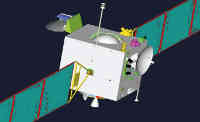
Chang'e 1
China National Space Administration Lunar OribiterCourtesy of NASA's National Space Science Data Center
Launch Date/Time: 2007-10-24 10:05 UT (6:05 a.m. EDT)
Mass: 2350 kg
Launch Vehicle: Long March 3A
Launch Site: Xichang, Peoples Republic of China
Discipline: Planetary Science
Description
The Chang'e 1 orbiter is the first of a planned series of Chinese missions to the Moon. The primary technical objectives of the mission are to develop and launch China's first lunar orbiter, validate the technology necessary to fly lunar missions, build a basic engineering system for lunar exploration, start scientific exploration of the Moon, and gain experience for subsequent missions. The primary science objectives are to obtain three-dimensional stereo images of the lunar surface, analyze the distribution and abundance of elements on the surface, survey the thickness of lunar soil and to evaluate helium-3 resources and other characteristics, and to explore the environment between the Moon and Earth.
Spacecraft and Subsystems
The orbiter is based on the DFH-3 Comsat bus and has a mass of 2350 kg, approximately half of which is propellant and 130 kg of which is the scientific payload. It is basically a 2.0 x 1.7 x 2.2 meter box with two solar panel wings extending from opposite sides. The science payload comprises eight instruments: a stereo camera system to map the lunar surface in visible wavelengths, an interferometer spectrometer imager to obtain multispectral images of the Moon, a laser altimeter to measure the topography, a gamma ray and an X-ray spectrometer to study the overall composition and radioactive components of the Moon, a microwave radiometer to map the thickness of the lunar regolith, and a high energy particle detector and solar wind monitors to collect data on the space environment of the near-lunar region.
Mission Profile
The spacecraft launched on 24 October 2007 at 10:05 UT (18:05 Chinese Standard Time, 6:05 a.m. EDT) on a CZ-3A (Long March 3A) booster from the no. 3 launching tower at Xichang Satellite Launch Center. The satellite was deployed into a 205 x 51000 km Earth orbit from the boosters upper stage at 10:29 UT. It was put into a trans-lunar trajectory with a 13 minute burn starting at 09:15 UT on 31 October which increased its speed to 10.9 km/s. It went into a 12 hour, 200 x 8600 km altitude near-polar lunar orbit with a 22 minute braking burn starting at 03:15 UT on 5 November. A second braking maneuver, from 03:21 to 03:35 UT on 6 November put the spacecraft into a 3.5 hour, 213 x 1700 km orbit and a third, from 00:24 to 00:34 UT on 7 November, slowed the probe to 1.59 km/s and put it into the final 127 minute, 200 km altitude, circular high-inclination science orbit. Chang'e 1 will orbit the Moon for a year to test the technology for future missions and to study the lunar environment and surface regolith.The Chang'e program is named for a Chinese legend about a young goddess who flies to the Moon. Funding for Chang'e 1 is 1.4 billion yuan, approximately U.S. $169 million.